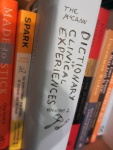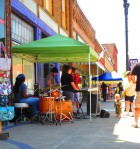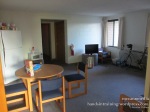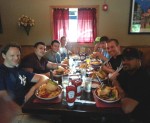campus, chiropractic college, classes, new york chiropractic college, recreation, Seneca Falls, students, studying
Making an Entrance: Answers for new student questions
Wisdom. It’s that thing that comes with experience, and makes even average people look sagely. That’s what this feels like right now, as I have in front of me a list of common questions from new incoming students at New York Chiropractic College, who arrive for classes in two weeks. This is like a culmination of the original goal of this blog, filling in the gaps missed by all the other college web pages.
Pre-requisite for new students: join the NYCC Casual Group on Facebook, where you can find other NYCC students of all levels. Ok, now let’s dig into this bag of inquisitions.
Academics
Q: What books should I begin reviewing over the summer?
Whoa, easy there, gunner. I can’t believe this was the very first question I got. So let’s get some priorities straight here. Over the next three years until clinic, you will be the busiest you’ve ever been in your life, absorbing mind-boggling amounts of information and being assessed constantly. Right now your best preparation includes catching up with friends and family before you move, wrapping up stray to-do list items, and getting into a healthy, relaxed mental state. Then you’ll be better able to start sopping up new knowledge on week one. I’m not even joking, if you’re looking to start studying, don’t.
However, if you want a little something just to geek out or get excited, I can condone that. Try learning a bit about musculoskeletal anatomy, or check out extracurricular reading like Anatomy Trains, Gray Cook on movement, Spark on exercise and learning, or work better with The One Thing. 
Q: What should I have for class on my first day of school?
A notebook and pen will generally suffice on day one, and maybe your iPad. After that, you’ll know how many binders and folders and such to buy. Most classes will give you a packet of lecture slides. Pro-tip: get one of the 4-color pens, and a set of highlighters. Also decide early if you’ll take your notes by hand or by tablet/laptop, and choose a robust note-taking app like iAnnotate.
Q: How many students will be in class?
This depends what season you start school. For classes entering in September, generally about 120. Classes who start their first trimester in January typically have around 40 students. Those who start in May will usually have 30 classmates. Lectures are in big groups, while labs will break down into much smaller sections. Here’s a typical breakdown.
Q: How can I sign-up for tutoring?
The AAESS (prounounced “ace”) office coordinates tutors. This will be really easy once you arrive in class- they will give you instructions and reminders. This is a really good call for most students!
Q: What are the student organizations and student leadership opportunities?
I like you a lot for asking this question. I dedicated my time to professional leadership with the Student American Chiropractic Assocation (SACA), both for our campus chapter and the national organization. You can take charge of local student leadership with the Student Government Association (SGA). There are also fantastic technique-oriented groups that WILL make you a better doctor. Two big ones right now are Rehab to Performance (R2P) which covers sports and rehab topics, and Motion Palpation (MoPal), which is all about palpation and adjusting. Check out Club Day for a comprehensive introduction to all the student organizations.
On-campus living
Q: What’s better for me… on or off campus living?
On-campus living is the pinnacle of convenience for classes, and is inherently social. Off-campus living includes amenities that dorms only dream of, like your own kitchen space.
Here, take a look.
Q: Do we have a kitchen and laundry in the dorm?
Yes. Every building has a kitchen in the basement, so for convenience make sure someone in the suite brings a microwave. Full-sized refrigerators are in every suite. Laundry facilities are also downstairs in each building, and use a reloadable payment card. Note: the laundry room is also great for singing.
Q: What does my dorm room have and what do I need to bring?
The bedrooms in Huron, Tuscarora, and Onondaga all have a twin XL bed/mattress, desk, chair, dresser, big closets, and curtains. The suite common rooms have a fridge, kitchen table, chairs, couch, overhead lights, and AC. BRING A FLOOR LAMP. Your bedroom won’t have any light otherwise. I mean, unless that’s how you like it.
Rooms are big for student accommodations. The bedrooms are approximately 12’ x 16’ in all of the buildings.
Q: Who am I living with?
Student life usually does a pretty good job of matching up good roommates (nobody is sure how). For privacy, roommates aren’t listed anywhere, but you can find each other via your class’ Facebook group. Most often you’ll live with other students from your class, and most suites house 4 people. I was placed with two students a year ahead of me, and that was fantastic.
Q: Can I move in early?
The Student Life office makes exceptions case by case.
Off-campus living
Q: If I live off-campus, where should I live?
In general, Seneca Falls has a lot of good options for housing, and very few people commute from anywhere other than there and eastern Waterloo. If you want to walk to campus, look at the eastern end of East Bayard Street or the northern portion of Lower Lake Road. If you want to walk to the lake, anywhere on Lower Lake Road will do the job nicely. If bars and food are your priority, live in the downtown area of Seneca Falls. There aren’t really ‘bad areas’ of downtown to avoid, but don’t live in the former motel at 55 West Bayard (if you saw it, this advice would go without saying). Good places to look for housing are Craigslist, Fall St. Rentals, and the listings maintained under “Student Life” in the student portal. Single bedroom apartments are usually around $600, and 3-4BR locations are more like $400 per person. The most I’ve heard of students paying is $800.
Q: Where can I live with pets?
It’s hard to speak for all the assorted private renters in town, who are mixed. Rivermist will allow cats, and Park Place and the Barringtons accept both cats and dogs.
Essential details
Q: Can I bring a car? Do I need a parking permit?
Yes, bring your car. Groceries, shopping, and pretty much any other attraction is at least a few miles from campus. There is tons of space for student parking, and parking permits are free.
Q: What is my school address?
Every student has a school mailbox- check it regularly. The address is listed in the student portal under “My Info”. Campus mailing address may not be updated until a week or so prior to arrival.
Q: Which meal plan do most students feel is the best value?
The minimum one, generally. The dining plans give you meal swipes and cash. Meals last one semester, and cash rolls over from semester to semester until the end of the spring trimester. Ready for some wisdom? Swipes are worth about $8.50, so if you have less food than that in your hands, don’t use a swipe for maximum value.
Q: How does my infirmary fee work?
This covers visits to the campus MD, Dr. Wirth, who is at the Seneca Falls Health Center on campus Tuesdays and Thursdays. You can also make an appointment at his office, but bring your student ID. The fee covers just the office visit.
The student clinic on campus is free to us, with both chiropractic and acupuncture available. You’ll have an intake appointment with them during your first trimester- DON’T MISS IT!
Q: Is there a Wal-Mart?
Of course. It’s ten minutes from campus in Waterloo- and ideal for when you realize the dorm rooms have no lights.
There’s also a great hardware store in town, Ferrara’s. For groceries, your in-town options are Tops, Aldi, and the legendary Sauder’s Market. Upstate’s favorite grocer, Wegmans, is great if you are willing to drive to Geneva or Auburn (I was).
Q: Where can I get a haircut, car repairs, etc.?
Tony’s and Trombley’s, respectively. Don’t confuse them.
Work hard play hard
Q: Where can I work? Are you hiring for work study?
Yes. Popular work study employers are the recreation center (gym/equipment managers, lifeguards), library, and Alumni office. Also stop by Advancement (photographers, writers), the Career Center, and Student Life. Other offices occasionally hire too, like the Registrar, student clinic, anatomy lab, or research. Admissions is a great place, but not until T2.
Off-campus jobs include retail at the Waterloo Outlets, hosts at the wineries (Knapp and Varick recently asked me to spread the word), and some of the downtown businesses.
Q: What is there to do in the area?

Wineries, cycling, trails, lake, bowling, skating, hiking, Ithaca, Geneva, Rochester, Syracuse… I’ve written entire blog posts about this one. Here’s what I did with my free time, and my Finger Lakes bucket list.
Wrap it up
You are going to be fine. Like I said before, take a breath, make sure you packed everything, and spend the next couple weeks enjoying yourself and being healthy. Class at NYCC is like the intellectual version of childbirth- a feat of physical endurance that you’ll look back on and say, “it was worth it.”
Also, this blog really is all for you. I want you to know what’s coming, and take the best approach when you get there. Here is another bit of advice that I put together for new students. Congratulations and see you soon!
Have more questions? Post them in the comments! Big thanks to Carol in Student Life and Steve in Admissions for contributing some Q’s and some A’s to this post. You can tweet at Brendan at @bhmccann.



Thanks for the insight! Quick question for you: What will we be using our iPads for exactly, and what kind of case would you recommend for it? Thanks again!
The iPads will be used for running Examsoft, a new setup here that will be the location for taking tests and keeping track of academic progress, strengths, and weaknesses. Like I said, it’s also great for taking notes in certain classes (like neuro) because then they are indexed for search when you review them.
I have Griffin case on mine, but it has a major drawback of not standing up well. I would recommend getting a case that allows you to stand up your iPad at 60-90 degrees, so you don’t have to spend so much time in cervical flexion. My classmate recommends Belkin.